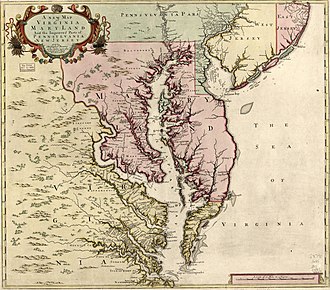Chesapeake Colonies
This article includes a list of references, related reading, or external links, but its sources remain unclear because it lacks inline citations. (January 2017) |

The Chesapeake Colonies were the Colony and Dominion of Virginia, later the Commonwealth of Virginia, and Province of Maryland, later Maryland, both colonies located in British America and centered on the Chesapeake Bay. Settlements of the Chesapeake region grew slowly due to diseases such as malaria. Most of these settlers were male immigrants from England who died soon after their arrival. Due to the majority of men, eligible women did not remain single for long. The native-born population eventually became immune to the Chesapeake diseases and these colonies were able to continue through all the hardships.
The Chesapeake region had a one-crop economy, based on tobacco. This contributed to the demand for slave labor in the Southern colonies. The tobacco also depleted nutrients in the soil,[1][2] and new land was continually needed for its cultivation. White indentured servants were also common in this region early in its settlement, gradually being replaced by African slaves by the latter half of the seventeenth century due to improved economic conditions in Europe and the resulting decrease in emigration to the Chesapeake region. Indentured servants were people who signed a contract of indenture requiring them to work for their Chesapeake masters for an average of five to seven years, in return for the cost of the Atlantic crossing. When finished, he might be given land,[3] or goods consisting of a suit of clothes, some farm tools, seed, and perhaps a gun.
See also
- First Families of Virginia
- Colonial families of Maryland
- Middle Colonies
- Southern Colonies
- Colonial South and the Chesapeake
- History of White Americans in Baltimore
- Old Stock Americans
- Province of Maryland
- Atlantic Creole
References
- ^ Lee Pelham Cotton (February 1998). "Tobacco: Colonial Cultivation Methods - Historic Jamestowne Part of Colonial National Historical Park (U.S. National Park Service)". www.nps.gov. Archived from the original on 16 July 2019. Retrieved 17 March 2020.
- ^ Carolyn Merchant (2007). American Environmental History: An Introduction. Columbia University Press. p. 50. ISBN 978-0-231-14035-5.
- ^ Kenneth Morgan (August 2001). Slavery and Servitude in Colonial North America: A Short History. NYU Press. pp. 8–9. ISBN 978-0-8147-5670-6.
Mark C. Carnes & John A. Garraty, The American Nation: A History of the United States, Pearson Education, 2006.
